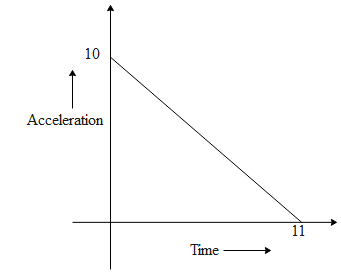
A particle starts from rest. Its acceleration (a) verses time (t) is as shown in the figure. The maximum speed of the particle will be:

$\begin{align}
& \left( A \right)110m/s \\
& \left( B \right)55m/s \\
& \left( C \right)550m/s \\
& \left( D \right)660m/s \\
\end{align}$

Answer
555.9k+ views
Hint: Given that the particle is initially at rest. Then the acceleration is the rate of change of its velocity. Since here the initial velocity is zero, acceleration is the rate of change in the final velocity. Thus to find the final velocity is obtained by integration. Here we will get a relation connecting the final velocity of the particle and area under the acceleration- time graph. By substituting the values we will get the solution.
Complete step by step answer:
Given,
The particle is initially at rest.
$u=0m/s$
Thus acceleration is the rate of change of the velocity with time.
$a=\dfrac{dv}{dt}$
Then rearranging the equation we get,
$dv=adt$
Hence by integrating we will get the final velocity.
$\int{dv=\int{adt}}$
$v=\int{adt}$ ……………..(1)
From the equation arrived, the velocity of the particle and area under the acceleration- time curve are equal.
In the given acceleration-time graph the area under the graph gives the maximum velocity.
Then,
${{v}_{\max }}=\dfrac{1}{2}\times base\times height$
From the graph substitute the value of base and height.
${{v}_{\max }}=\dfrac{1}{2}\times 11\times 10$
${{v}_{\max }}=55m/s$
So, the correct answer is “Option B”.
Additional Information: The velocity is defined as the change in object’s position from one point to other with respect to the time. It is a vector quantity like acceleration.
Note: The area under the graph of acceleration-time gives the change in velocity. Thus acceleration is the rate of change of the velocity with time. If the velocity is just in the opposite direction then acceleration will have negative value. This is termed as deceleration. The slope of the velocity time graph gives acceleration. That is, the motion is retarded.
Complete step by step answer:
Given,
The particle is initially at rest.
$u=0m/s$
Thus acceleration is the rate of change of the velocity with time.
$a=\dfrac{dv}{dt}$
Then rearranging the equation we get,
$dv=adt$
Hence by integrating we will get the final velocity.
$\int{dv=\int{adt}}$
$v=\int{adt}$ ……………..(1)
From the equation arrived, the velocity of the particle and area under the acceleration- time curve are equal.
In the given acceleration-time graph the area under the graph gives the maximum velocity.
Then,
${{v}_{\max }}=\dfrac{1}{2}\times base\times height$
From the graph substitute the value of base and height.
${{v}_{\max }}=\dfrac{1}{2}\times 11\times 10$
${{v}_{\max }}=55m/s$
So, the correct answer is “Option B”.
Additional Information: The velocity is defined as the change in object’s position from one point to other with respect to the time. It is a vector quantity like acceleration.
Note: The area under the graph of acceleration-time gives the change in velocity. Thus acceleration is the rate of change of the velocity with time. If the velocity is just in the opposite direction then acceleration will have negative value. This is termed as deceleration. The slope of the velocity time graph gives acceleration. That is, the motion is retarded.
Recently Updated Pages
Master Class 11 Business Studies: Engaging Questions & Answers for Success

Master Class 11 Computer Science: Engaging Questions & Answers for Success

Master Class 11 Maths: Engaging Questions & Answers for Success

Master Class 11 Chemistry: Engaging Questions & Answers for Success

Master Class 11 Economics: Engaging Questions & Answers for Success

Master Class 11 Accountancy: Engaging Questions & Answers for Success

Trending doubts
What is meant by exothermic and endothermic reactions class 11 chemistry CBSE

10 examples of friction in our daily life

One Metric ton is equal to kg A 10000 B 1000 C 100 class 11 physics CBSE

1 Quintal is equal to a 110 kg b 10 kg c 100kg d 1000 class 11 physics CBSE

Difference Between Prokaryotic Cells and Eukaryotic Cells

What are Quantum numbers Explain the quantum number class 11 chemistry CBSE




